The Yukon government’s comprehensive municipal grant (CMG) will allocate $18.9 million to Yukon municipalities this year.
That increase over last year’s figure of $18.173 million is due to a $50,000 funding supplement to each municipality that has been made permanent, said Samantha Crosby, community advisor with the Department of Community Services.
“For the last five years there has been a supplementary grant that each municipality gets on top of their total basic grant amount,” she said. “But they had that added on after. Now, with the change, the $50,000 is moved into the base amount.”
“The $50,000 previously was identified to help address compliance with regulatory requirements (for things such as solid waste, clean water and waste water management).… making it permanent would recognize these regulatory compliance issues are a permanent part of running a municipality.”
Crosby said each municipality will receive a base funding amount of $725,000. In 2017 the base amount was $675,000.
From there, a formula is used to determine additional funding for each municipality. This is calculated using the base amount for each municipality, and considering factors including population, properties, infrastructure and tax base. Crosby said it’s then indexed by the Consumer Price Index.
Crosby said the government arrived at the new funding decisions last summer when a working group, comprised of representatives from YG and the Association of Yukon Communities, did a three-month review of the CMG.
The CMG was established in 1991 to provide unconditional block funding to help municipalities fund services including water and waste, recreation, garbage pick-up and more.
However, Crosby said the previous fund was a “closed fund.”
That means there was a cap on funding, she said. If one municipality had an increase in its funding in certain areas, other municipalities would get less.
In 2012, Crosby said YG worked with AYM to get the municipalities’ perspectives on the way funding was working.
The result was the five-year plan that was reviewed in 2017.
“With the new formula there isn’t a cap on the funding so if one municipality sees a large increase it won’t have a negative effect on another municipality,” Crosby said.
The “open fund” also ensures that, over the next five years, no municipality will see its funding drop below 2017 funding levels.
Crosby said this funding plan will be in place from 2018 to 2022, at which point it will be reviewed once again by YG and AYM to determine whether it’s working.
There are no specifics, but in addition to the $700,000 increase for municipalities in 2018, the government anticipates further increases over the next five years.
Municipalities will receive funding from YG on April 3.
Carmacks and Teslin will each receive around $1.3 million. Dawson City will receive nearly $2.3 million. Faro and Haines Junction will each receive around $1.7 million. Mayo will receive $1.5 million. Watson Lake will receive more than $2 million. Whitehorse will receive more than $7 million.
Contact Amy Kenny at amy.kenny@yukon-news.com
